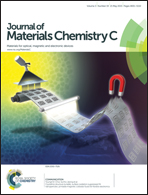Effects of spontaneous nitrogen incorporation by a 4H-SiC(0001) surface caused by plasma nitridation†
Abstract
Change in defect states in the nitrided 4H-SiC(0001) channel formed by a plasma nitridation (PN) process was investigated as a function of rapid processing time (180 s) at room temperature. The electronic structure of the interface between the nitride layer and the SiC substrate was investigated using X-ray photoelectron spectroscopy (XPS), medium-energy ion scattering (MEIS) and first-principles DFT calculations. The findings clearly showed that N adsorption occurred through the spontaneous incorporation at the SiC subsurface, resulting in the formation of an N-laminated structure at the interface. The results are consistent with an enhancement in the interface electrical characteristics because the energetically most stable gap state of SiC could only be observed in the N-laminate structure. In particular, the stress induced leakage current (SILC) characteristics showed that the generation of the defect state was significantly suppressed in a metal oxide semiconductor (MOS) structure with a nitride layer. These results provide an in-depth understanding of the process involved in the incorporation of N into the SiC subsurface and for the enhanced electrical characteristics of the interfacial nitride layer on SiC in the PN system.


 Please wait while we load your content...
Please wait while we load your content...